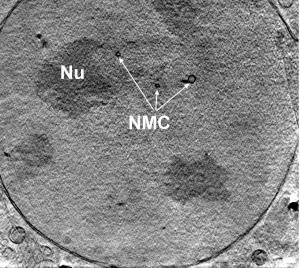Three-dimensional model of bacterium
New methods of electron microscopy decode the structure of Gemmata obscuriglobus
Advertisement
Certain bacteria can build such complex membrane structures that, in terms of complexity and dynamics, look like eukaryotes, i.e., organisms with a distinct membrane-bound nucleus. Scientists from Heidelberg University and the European Molecular Biology Laboratory (EMBL) made this discovery employing new methods in electron microscopy. The research team succeeded in building a three-dimensional model of the Gemmata obscuriglobus bacterium, including the structure of its membrane system. Their studies proved, however, that the G. obscuriglobus does not have a “true” nucleus. Despite this outlier characteristic, it remains classified as a bacterium and thus a so-called prokaryote.
“Since the beginning of microscopy, cells of living organisms have been classified into one of two categories,” explains Dr. Damien Devos, a researcher at the Centre for Organismal Studies (COS) at Heidelberg University. Eukaryotes “pack” their genetic material, their DNA, in an area enclosed in a membrane, the nucleus. Prokaryotes, however, which also include bacteria, do not have that type of cell nucleus. Several years ago, analyses using new techniques of two-dimensional imaging had suggested that the genetic material of G. obscuriglobus was surrounded by a double membrane – this and other unique characteristics of membrane structure called into question the differentiation between prokaryotes and eukaryotes.
“The possibility that a bacterium could have a structure similar to a cell nucleus threatened to unhinge one of the central assumptions of biology on which countless other analyses and interpretations were based,” explains Damien Devos. To study the unique features of the membrane structure in the G. obscuriglobus more closely, the Heidelberg researchers divided the bacterium into thin slices and examined them using an electron microscope. The slices were used to detect the membranes, track their course throughout the entire bacterium and reconstruct their organisation on the computer. This created a virtual model of G. obscuriglobus, which enabled the researchers to visualise the membrane organisation in three-dimensional space and analyse how the membranes were structured within the cell.
The studies demonstrated that the membranes within the G. obscuriglobus are only one part of the interior membrane that is present in all bacteria and that surrounds the cytoplasm. “G. obscuriglobus also evidenced additional characteristics that are found in other bacteria,” explains Damien Devos. According to the researcher, these results disprove the assumption of the existence of a bacterial cell nucleus. “The cell structure and the membranes of the Gemmata obscuriglobus are simply more complex than in ‘classic’ bacteria. Therefore, G. obscuriglobus does not constitute a new, separate group of organisms, and it cannot be classified a eukaryote,” says Dr. Devos, who collaborated with Rachel Santarella-Mellwig of the European Molecular Biology Laboratory.





















































